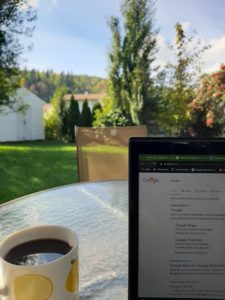Digital literacy is a term that is especially relevant for teachers today due to the rapid development of technology. Digital literacy refers to the idea that we need to be able to take in new information, evaluate them critically, use it to solve problems, apply it to create, all while being safe and respectful to others (Gov. B.C. 2020). It is important for teachers to include digital literacy in their classroom is to highlight how to be safe with technology because there are risks. These risks can include information security, crude content, and cyber bullying (Frankel et al., 2020; Hsu et al., 2019; Vandoninck et al., 2010). In addition, students also need skills in digital literacy and adaptability in order to take advantages of the different opportunities that arise (Hsu et al., 2019). Therefore, teaching digital literacy in schools will teach kids skills to be come better adapted the high paced technological world.

Teaching digital literacy is a unique challenge of the present. Trying to keep up with the digital quo and find age appropriate or skill appropriate technology requires a lot of work. One useful model that was effective in teaching digital literacy is called the spiral learning model (Hsu et al., 2019). It uses the principle that you introduce a technique, and then start spiraling up the difficulty. It requires students to draw on their previous knowledge form other projects along with using problem solving skills (Hsu et al., 2019). For example, in a high school science class, I may introduce the idea of critically assessing internet sources with a topic that was already learned in class. This way students are familiar with the content and can then see if the information presented in the source matches their previous knowledge, and can then assess the author and website credibility. To follow, I may do a similar activity again but with another layer new skill, producing the spiral effect. However, Hsu et al. (2019) found the only aspect of digital literacy not enhanced by their model was digital citizenship since there was not specific task that explicitly require it. In an article, Clarke (2020) explained a project that approaches the ethical side of digital literacy and digital citizenship. In the project students around the world tell their stories, listen to others, comment, reflect and expand on how this was similar or different from their lives. Allowing them to comment, contact, and expand on students lives outside of their own countries in addition to building their skills for digital writing, posting pictures, and being respectful, and asking questions about others cultures (Clarke, 2020).
All seeming fine and dandy, the concept of teaching digital literacy does have some concerns. Although the consequences of teaching digital literacy are not quite known, one author published a paper questioning what might happen with excessive use of technology (Laidlaw & O’Mara, 2015). For example, loss of handwriting and other fine motor skills due to the trend towards using digital means instead of physical (Laidlaw & O’Mara, 2015).
I also extrapolated off this idea and questioned if there will be an effect on reading ability since libraries are trying to keep up with the popularity technology and using audiobooks. Lastly, I would be concerned that teaching digital literacy usually leans towards using more technology in class – would it provide an unequal learning opportunity to students with who do not have the same access to technology? Will this impact their ability to produce work or even give them a fair turn to learn the skills they need? If not, will this influence their mental health?
Clarke, L. W. (2020). Walk a Day in My Shoes: Cultivating Cross-Cultural Understanding Through Digital Literacy. Reading Teacher, 73(5), 662–665. https://doi.org/10.1002/trtr.1890
Frankel, K. K., Deanna, M., Editors, B., Brooks, M. D., & Frankel, K. K. (2020). Pathways for Educators to Challenge Deficit Perspectives: Adolescents’ Transnational Digital Literacy Practices in the Classroom. Journal of Adolescent & Adult Literacy, 63(6), 711–714. https://doi.org/10.1002/jaal.1042
Hsu, H. P., Wenting, Z., & Hughes, J. E. (2019). Developing Elementary Students’ Digital Literacy Through Augmented Reality Creation: Insights From a Longitudinal Analysis of Questionnaires, Interviews, and Projects. In Journal of Educational Computing Research (Vol. 57, Issue 6). https://doi.org/10.1177/0735633118794515
Laidlaw, L., & O’Mara, J. (2015). Rethinking Difference in the iWorld: Possibilities, Challenges and ‘Unexpected Consequences’ of Digital Tools in Literacy Education. Language and Literacy, 17(2), 59. https://doi.org/10.20360/g2hc7k
Provincial Government of British Columbia. Digital Literacy. https://www2.gov.bc.ca/gov/content/education-training/k-12/teach/teaching-tools/digital-literacy
Vandoninck, S., D’Haenens, L., & Donoso, V. (2010). Digital literacy of flemish youth: How do they handle online content risks? Communications, 35(4), 397–416. https://doi.org/10.1515/COMM.2010.021

